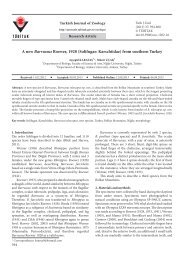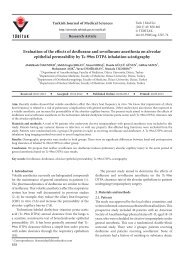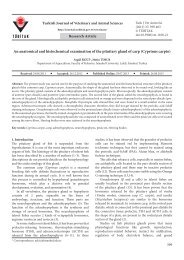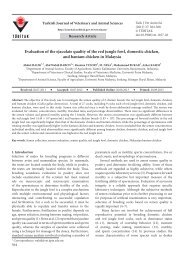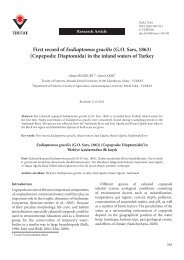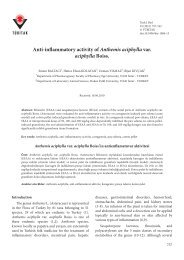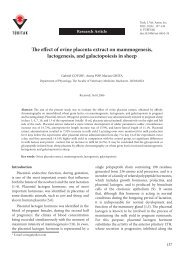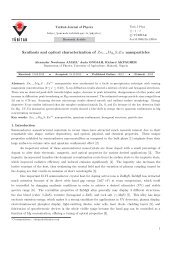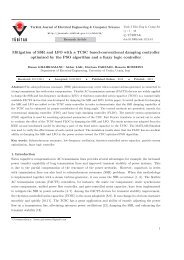Preliminary study on Acropora - Scientific Journals - Tübitak
Preliminary study on Acropora - Scientific Journals - Tübitak
Preliminary study on Acropora - Scientific Journals - Tübitak
You also want an ePaper? Increase the reach of your titles
YUMPU automatically turns print PDFs into web optimized ePapers that Google loves.
Figure 4. <strong>Acropora</strong> horrida: a) porti<strong>on</strong> of col<strong>on</strong>y; b) porti<strong>on</strong> of<br />
branch; c) SEM micrograph showing terminal part of branch;<br />
d) SEM micrograph showing coenosteum <strong>on</strong> radial corallite; e)<br />
SEM micrograph showing 2 simple, laterally flattened spinules<br />
between radial corallites; f) top view of axial corallite, note the<br />
absence of sec<strong>on</strong>dary septal cycle; g) high-magnificati<strong>on</strong> SEM<br />
micrograph showing ornamentati<strong>on</strong>s <strong>on</strong> coenosteum between<br />
radial corallites.<br />
Remarks: Of this species, 1 specimen was sent to the<br />
Museum of Tropical Queensland, where C.C. Wallace<br />
identified it as <strong>Acropora</strong> cf. horrida. Detailed and careful<br />
examinati<strong>on</strong> of other specimens from the same dive and<br />
of additi<strong>on</strong>al specimens collected later <strong>on</strong> allowed us to<br />
c<strong>on</strong>firm the identificati<strong>on</strong>.<br />
Comparis<strong>on</strong> between the measurements of the<br />
specimen found in the present <str<strong>on</strong>g>study</str<strong>on</strong>g> with those described<br />
by Wallace (1999) indicated that branches of almost the<br />
same diameter were much shorter in our specimens. The<br />
other measurements more or less overlapped.<br />
<strong>Acropora</strong> downingi Wallace, 1999; Figures 5a–5f<br />
Material examined: Iran, Larak Island: 26°53′07.8″N,<br />
56°23′59.0″E; depth 3 m; 7 October 2008; MMTT Cnid.<br />
1022. Larak Island: 26°53′16.3″N, 56°21′01.3″E; depth 6<br />
m, 11 October 2008; MMTT Cnid. 1172. Khark Island:<br />
29°12′36.6″N, 50°19′56.5″E; depth 3 m; 14 December<br />
2009; MMTT Cnid. 1404. Farur Island: 26°17′44.1″N,<br />
312<br />
RAHMANI and RAHIMIAN / Turk J Zool<br />
54°32′22.4″E; depth 6 m; 28 October 2009; MMTT Cnid.<br />
1382. Khark Island: 29°16′34.4″N, 50°18′31.7″E; depth 9<br />
m; 20 December 2009; ZUTC Cnid. 1708.<br />
Descripti<strong>on</strong>: Branching pattern: Arborescent table,<br />
large, some up to 3 m in diameter (Figure 5a), both single<br />
and multilayered table forms present; some branches<br />
grow upwards; branches tapering slightly towards the tip<br />
(Figures 5b and 5c), anastomosed branches forming solid<br />
central plate; branch diameters: 5.4–14.8 mm, 4.8–13.6<br />
mm, 4.2–9.1 mm; branch length up to 62.0 mm; growth<br />
determinate.<br />
Axial corallites: Small cylindrical; outer diameter<br />
0.9–2.5 mm; calice diameter 0.6–1.6 mm; round to oval<br />
opening; 1 or 2 septal cycles present (Figure 5e), primary<br />
septa 1/2R, directive septa sometimes touching; sec<strong>on</strong>dary<br />
septa absent or inc<strong>on</strong>spicuous; septal length increasing<br />
downwards.<br />
Radial corallites: Crowded and fragile; various sizes<br />
(Figure 5c); tubular, with oblique opening and upward<br />
sharp edges (Figure 5d); profile length 1–4 mm; some<br />
corallites immersed, especially those at the base of<br />
branches; primary septa seldom present (in most cases<br />
<strong>on</strong>ly directive septa present), when present maximum<br />
1/4R.<br />
Coenosteum: Coenosteum <strong>on</strong> radial corallites proper<br />
costate (Figure 5d), broken-costate, or linearly arranged,<br />
laterally flattened spinules; coenosteum between radials<br />
reticulate with simple spinules (Figure 5f).<br />
Color: Brown to dark green or gray; branch tips pale<br />
or white.<br />
Remarks: Our preliminary studies indicated that<br />
<strong>Acropora</strong> downingi has 2 forms in the <str<strong>on</strong>g>study</str<strong>on</strong>g> area. In <strong>on</strong>e<br />
form, some branches grow upwards, unlike in the sec<strong>on</strong>d<br />
form, which has no upright branches <strong>on</strong> the table. The<br />
latter form might have been misidentified as A. clathrata.<br />
Further tax<strong>on</strong>omic work <strong>on</strong> these growth forms is<br />
currently underway. A. clathrata was not found during<br />
the present <str<strong>on</strong>g>study</str<strong>on</strong>g>. C<strong>on</strong>sequently, it is likely that either the<br />
reports of A. clathrata from the southern (and western)<br />
Persian Gulf (Sheppard and Sheppard, 1991; Hodgs<strong>on</strong><br />
and Carpenter, 1996; Riegl, 1999; Abdel-Moati, 2011) are<br />
a misidentificati<strong>on</strong> of A. downingi (see Wallace, 1999) or<br />
that A. clathrata is restricted to the southern (and western)<br />
part of the Persian Gulf, or it is an extremely rare species in<br />
this part of the Persian Gulf (see discussi<strong>on</strong>).<br />
<strong>Acropora</strong> arabensis Hodgs<strong>on</strong> and Carpenter, 1996;<br />
Figures 6a–6g<br />
Material examined: Iran, Larak Island: 26°53′16.3″N,<br />
56°21′01.3″E; depth 6 m; 11 October 2008; MMTT<br />
Cnid. 1153. Larak Island: 26°53′16.9″N, 56°21′00.4″E;<br />
depth 9 m; 11 October 2008; MMTT Cnid. 1239. Larak<br />
Island: 26°53′12.1″N, 56°23′32.1″E; depth 3 m; 8 October<br />
2008; MMTT Cnid. 1125. Farur Island: 26°16′52.4″N,



